The 2022 Ecosystem Monitoring Fund has a wide focus in an effort to best capture the needs of the community. Proposals in support of new or existing monitoring programs of forested ecosystems in the seven-state FEMC region will be accepted. If you have questions about eligibility or the evaluation process, please contact Elissa Schuett.
Submission Deadline:
March 25, 2022
Funding Amount:
$25,000 maximum; 1:1 non-federal match required
Contact:
Objectives of the Ecosystem Monitoring Fund
The Ecosystem Monitoring Fund will support forest ecosystem monitoring projects in the seven-state FEMC program area. The goal is to provide support for the collection, aggregation, analysis, and utilization of forest ecosystem monitoring information to better understand the current threats, historical trends, and future directions of the forested landscape in the Northeast.
Project Types: A wide range of project types will be considered for funding. As examples of the breadth of activities the FEMC hopes to support, this may include:
- the implementation of new monitoring programs to fill a critical gap in our understanding of forest response to novel stressors,
- upgrading an existing monitoring program to increase comparability with others in the region,
- aggregation of disparate data sets to expand the relevance of existing data,
- continuation and maintenance of existing long-term monitoring sites,
- digitization of key historical data sets to examine historical trends,
- collection of additional monitoring field data to address emerging needs,
- support or improvement of continuously deployed monitoring instrumentation,
- development of geospatial products to explore landscape patterns.
Project Focus: Projects may include any monitoring efforts related to forest ecosystem function, structure, and health. This may include forest vegetation, ecosystem services, invasive species, wildlife, water, soil, weather and climate, or air quality. Proposals for monitoring programs outside of these topics and activity types are welcome as long as there is a clear connection made to forest ecosystems in the Northeast.
Project Duration: Projects can be funded for up to two years.
Fund Priorities: FEMC’s recent work generally focuses on the following themes:
- Forest Pests and Disturbance Regimes
- Forest Inventory and Relationship to Carbon and Management
- Climate Change Impacts on Forested Ecosystems
- Forest Regeneration
- Recreation and Forest Health
- Forest Ecosystem Data Rescue and Preservation
- Forest-Water and Forest-Wildlife Intersections
FEMC’s guiding committees have identified several priority topics of interest within these themes that would benefit from increased or improved monitoring. These priorities are not exhaustive – but meant to guide selection of successful proposals to fund.
- Identifying patterns and nature of tree mortality following recent acute disturbance events
- Improving data sources and/or extending the historical record of disturbances in FEMC’s Disturbance Regimes tool: https://www.uvm.edu/femc/disturbance
- Developing regional baselines of invasive plant distribution and/or current state of knowledge on distribution and ecosystem effects
- Integrating regionally specific remote sensing-based tools to detect and monitor forest clearing, forest conversion, land use change and/or forest health
- Expanding or adding monitoring to track forest health outcomes related to forest-based recreation
- Integrating and communicating monitoring information on changing hydrology in forests due to climate change and/or development (i.e., what is the pattern of exceeding 100-yr flood stage due to climate change)
Funding Availability: A total of $100,000 is available in funding to support projects of up to $25,000 for up to two years, beginning in 2022. A 1:1 match of non-federal funds is required. It is anticipated that four to six projects will be funded.
Deadlines
| Proposals due | March 25, 2022 |
| Reviews complete | April 8, 2022 |
| Awards announced | April 18, 2022 |
| Awards begin | May 2, 2022 |
| Awards complete | May 19, 2024 |
Eligibility
Proposals will be accepted from personnel from universities, non-profit, state, tribal, or private organizations located in one of the FEMC member states: Connecticut, Maine, Massachusetts, New Hampshire, New York, Rhode Island, or Vermont. Investigators from other states can be included as co-author on the proposal but cannot lead the project. Monitoring must be conducted primarily within one of the seven listed states. Monitoring conducted outside of these states with matching funds can be included.
Diversity
FEMC is committed to integrating principles of diversity, equity, inclusion, and justice (DEIJ) into our monitoring programs. FEMC will implement approaches in this RFP to reach diverse communities, both to conduct monitoring and who may benefit from monitoring. We encourage proposals from underrepresented organizations, or that will provide valuable information to these communities. Please include in the proposal narrative (see below) a description of how FEMC DEIJ goals will be met with this proposal. The details can be included throughout the proposal, but also specifically in the rationale, objectives, or outcomes sections.
Lead PI: Colin Beier
Organization: SUNY ESF
The need for reliable landscape scale forest monitoring tools is growing rapidly with the advent of climate goals that promote the use of forests as natural climate solutions. Existing monitoring tools were not developed for the forest types and disturbance regimes that are present in the Northern Forest region. Our recent ground truthing analysis of three of the most common satellite based disturbance detection algorithms found that they largely underperformed in detecting the uneven aged harvests that are prevalent in this regions. Thus, our goal is to tune and train a forest change detective specifically for the forest types and disturbance regime of the Northern Forest. Our approach utilizes an iterative tuning process and three sources of ground truthing data: harvest records, visual verification software (TimeSync) and field visits. We request FEMC assistance to help us address the need for efficient and accurate forest monitoring for climate and ecosystem stewardship, as well as to meet the needs of landowners and managers.
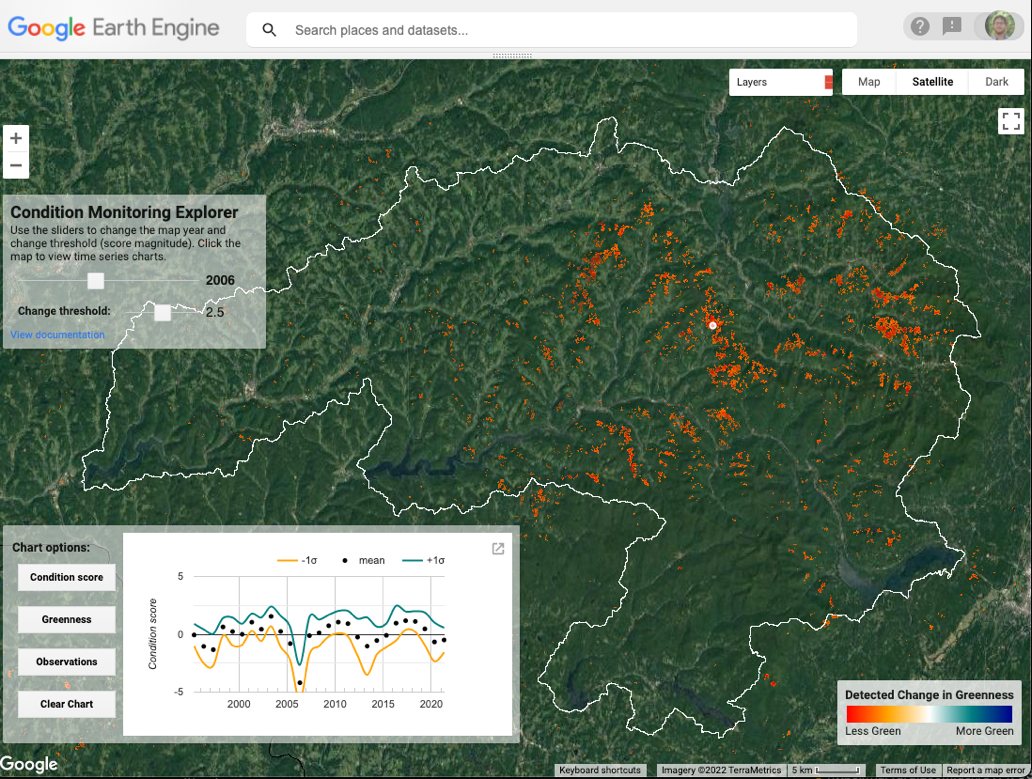
PIs: Jonathan Thompson
Organization: Harvard University/Harvard Forest
Monitoring the forest conditions within the 2000 sq mile New York City Watershed is a challenge with direct impacts on more than 9-million people who depend on it for clean drinking water. For decades, the New York Department of Environmental Protection (DEP) has maintained a vast network of field plots, which serve as their primary means of monitoring forest changes due to land use, insects, droughts, and other disturbances. We propose to integrate these plot data with historical and current Landsat-based vegetation indices within a custom Google Earth Engine (GEE) application that will enable retrospective and near real-time assessments of changing forest conditions throughout the Watershed. The Condition Monitoring Tool will identify and map anomalies in canopy condition and allow DEP staff to efficiently relate the remotely sensed disturbances to observed field plot information. This integration will add tremendous value to both the remote sensing data and the field data.
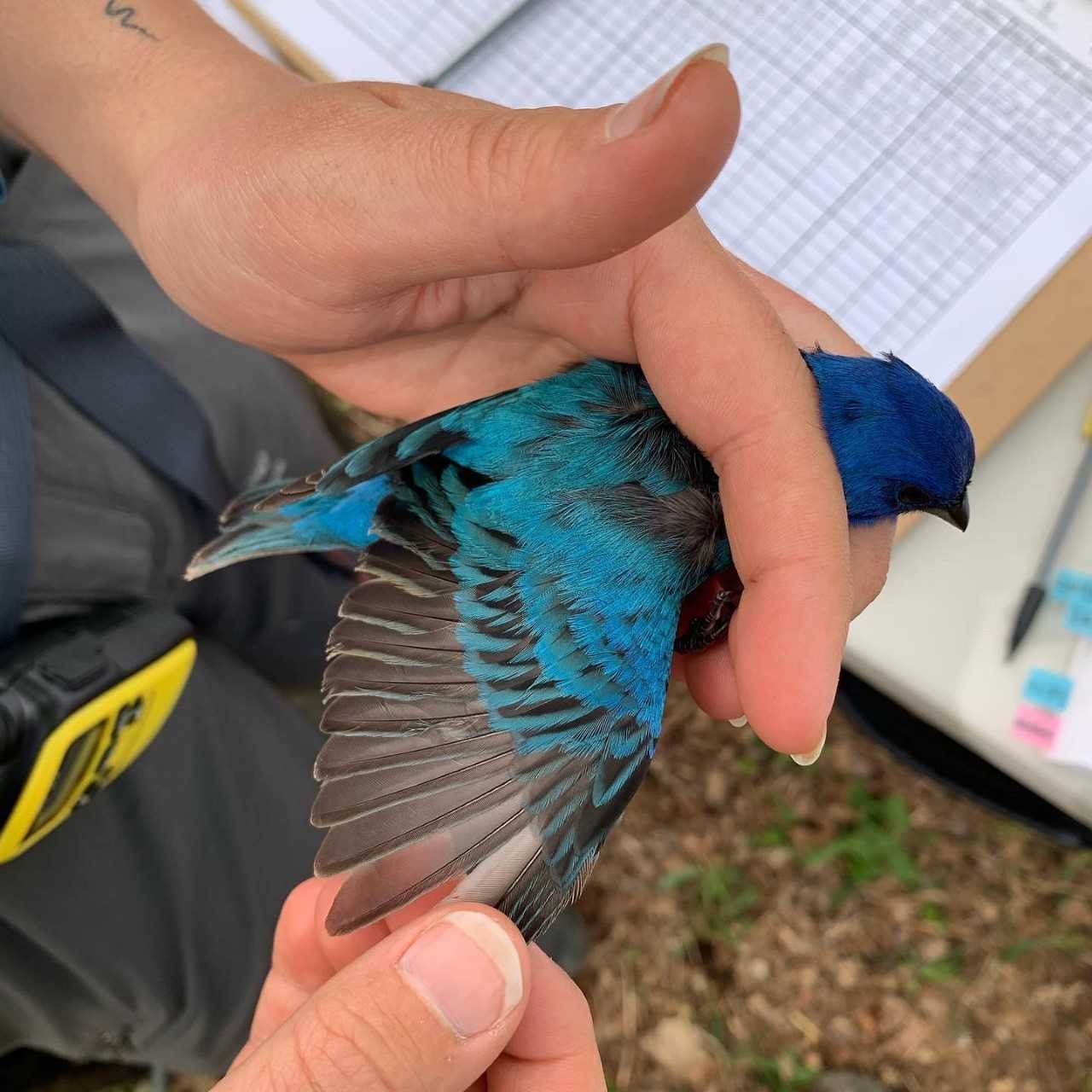
Lead PI: Benjamin Nickley
Organization: Green Berkshires Inc.
In our Northeastern forests, wildlife is facing pressure on multiple fronts as a result of habitat destruction and climate change. Accurate knowledge of population trends is necessary to identify and establish policies to stem population declines. Birds often serve as the focus of wildlife monitoring efforts due to their utility in signaling broader ecological trends. The Breeding Bird Survey (BBS), a large-scale, long-term monitoring program, is designed to track bird populations. Though the BBS provides crucial data, it falls short with respect to many migratory birds in the Northeast. Nocturnal birds, like the Northern Sawwhet Owl, are simply not sampled. Most of the Northeast’s neotropical migrants have breeding ranges encompassing large parts of the boreal forest and are inadequately sampled. These birds require additional monitoring. During migration, many move through the Appalachian Mountains to take advantage of resources forested tracts provide. In places where migrants concentrate, individuals representing multiple breeding populations can be efficiently monitored at a single locale. We propose establishing a migration bird banding station in western Massachusetts to monitor birds as they migrate through the Taconic range. Our banding station will provide critical data on migration phenology, population trends and other demographic parameters. In addition to helping fill a gap in existing bird monitoring efforts, we anticipate engaging our community and serving as a regional bird research hub.
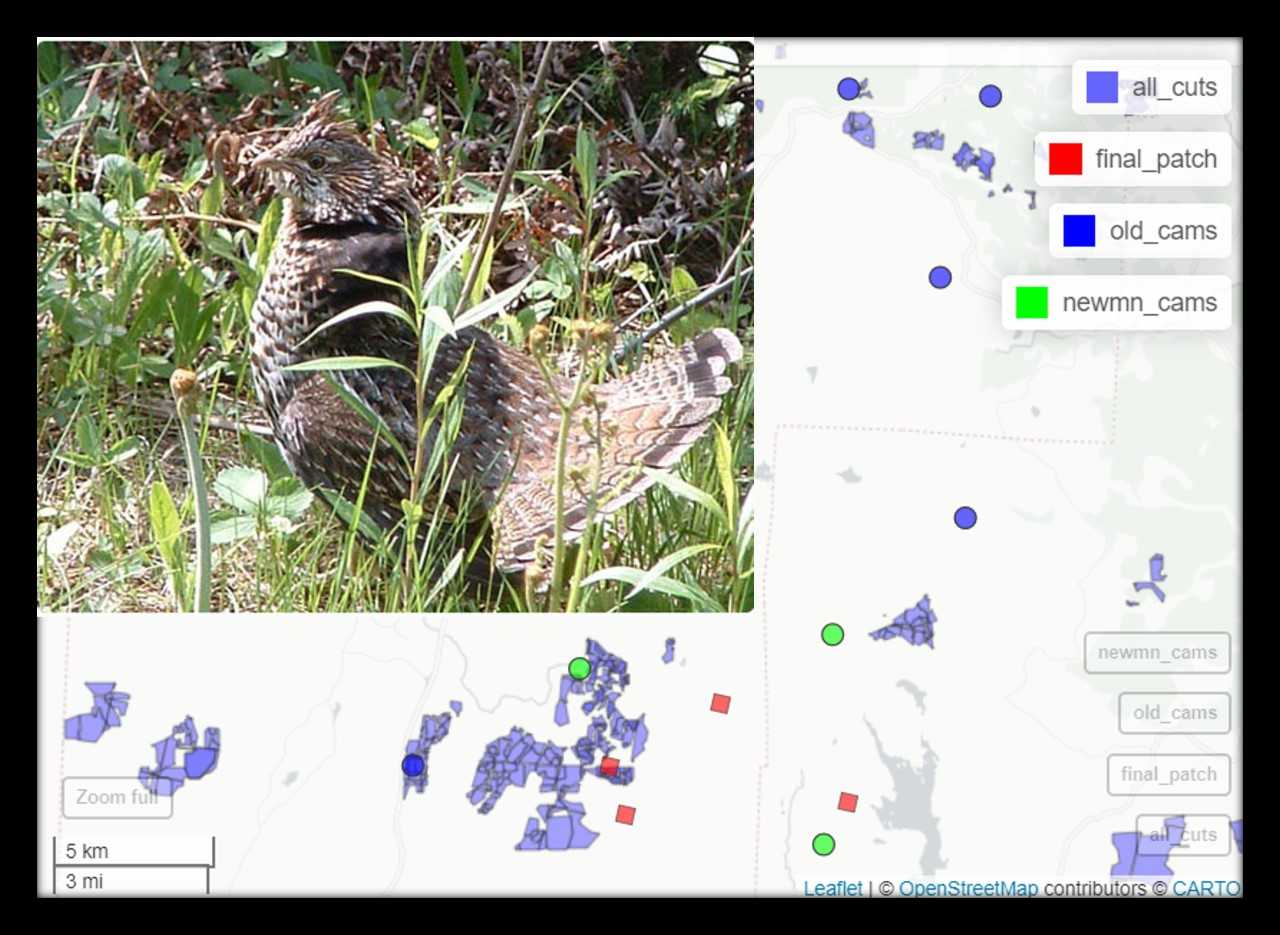
Lead PI: Katherina Gieder
Organization: VT Fish and Wildlife
Green Mountain National Forest (GMNF) in Vermont initiated an early successional habitat creation project in 2020 covering 15,000 acres of timber harvest treatments implemented over 15-years to increase the acreage of regenerating age class (0 to 9 years old) forest. The main objective is to improve habitat for neotropical migrant birds and other early successional-dependent wildlife species. GMNF needs an efficient solution and decision-making tool for long term forest ecosystem monitoring that can integrate multiple different taxa and scales. We propose expanding on an existing monitoring framework that uses autonomous monitoring units and automated open-source data processing and analysis tools as a long term ecosystem monitoring tool for adaptive management decision-making with the overall aim to 1) further understand multi-species response to forest change, and 2) support long term comprehensive multi-species monitoring needs.
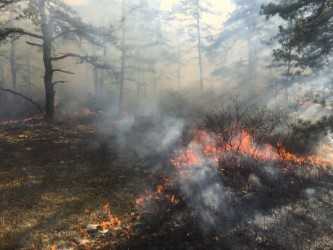
Lead PI: Ryan Rebozo
Organization: Vermont Center for Ecostudies
Many oak forests in the eastern united states have been experiencing a shift in species composition that is often attributed to mesophication. As a result, the use of prescribed fired in these habitats has gained attention in recent years as a management strategy to maintain an oak dominated component in these systems. Fire has been used successfully in oak forests to achieve management goals but its efficacy is often dependent on a variety of local factors. In addition to supporting regeneration of target canopy tree species, prescribed fire can be used to maintain fire adapted understory species. This project aims to include additional variables to the monitoring of managed dry oak forests such as local deer density, duff layer conditions and priority host plant species. These data will be used to compared treatment vs. control sites and to create a better understanding of additional pressures to regeneration, signs of mesophication and potential for support rare wildlife species that will inform future monitoring and management efforts.
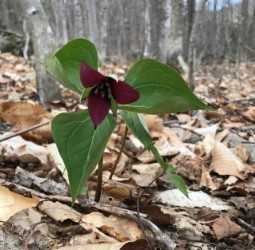
Lead PI: Georgia Murray
Organization: Appalachian Mountain Club
Mountain ecosystems are often understudied due to remote access and difficult conditions. Yet mountains may serve as climate refugia as lowlands are changing more rapidly. A recent analysis led by AMC researchers of 84 years of temperature and snow data reveals even the highest elevation, Mount Washington, is now warming and the condition of winter is changing; however, some inconsistencies with elevation were also identified [1]. In addition to physical conditions, AMC has been monitoring plant phenology, a bioindicator of climate change, for decades in the White Mountains, NH. However, we do not currently have adequate information to connect potential shifts in phenology across the broader context of the Northern Appalachian region, which is critical in understanding adaptation under future climate scenarios. Our organization is well positioned to sustain and expand mountain climate and plant phenology monitoring with our existing staff and infrastructure and to engage the surrounding underserved rural communities in hands-on learning. Here we propose to continue, expand, and share our ongoing plant phenology, snow, and air and soil temperature datasets through expanding our citizen science programs, allowing additional spatial analysis. This work will improve our understanding of how upland forest ecosystems are responding to climate change and will engage outdoor recreationists in community science data collection, filling gaps around traditional stationary plots and sensors. We will engage low-income disadvantaged communities near our NH and ME facilities through our education program that works with local schools, through targeted community trainings, and by highlighting the impacts of climate change on local economies via our online media and project reports.
